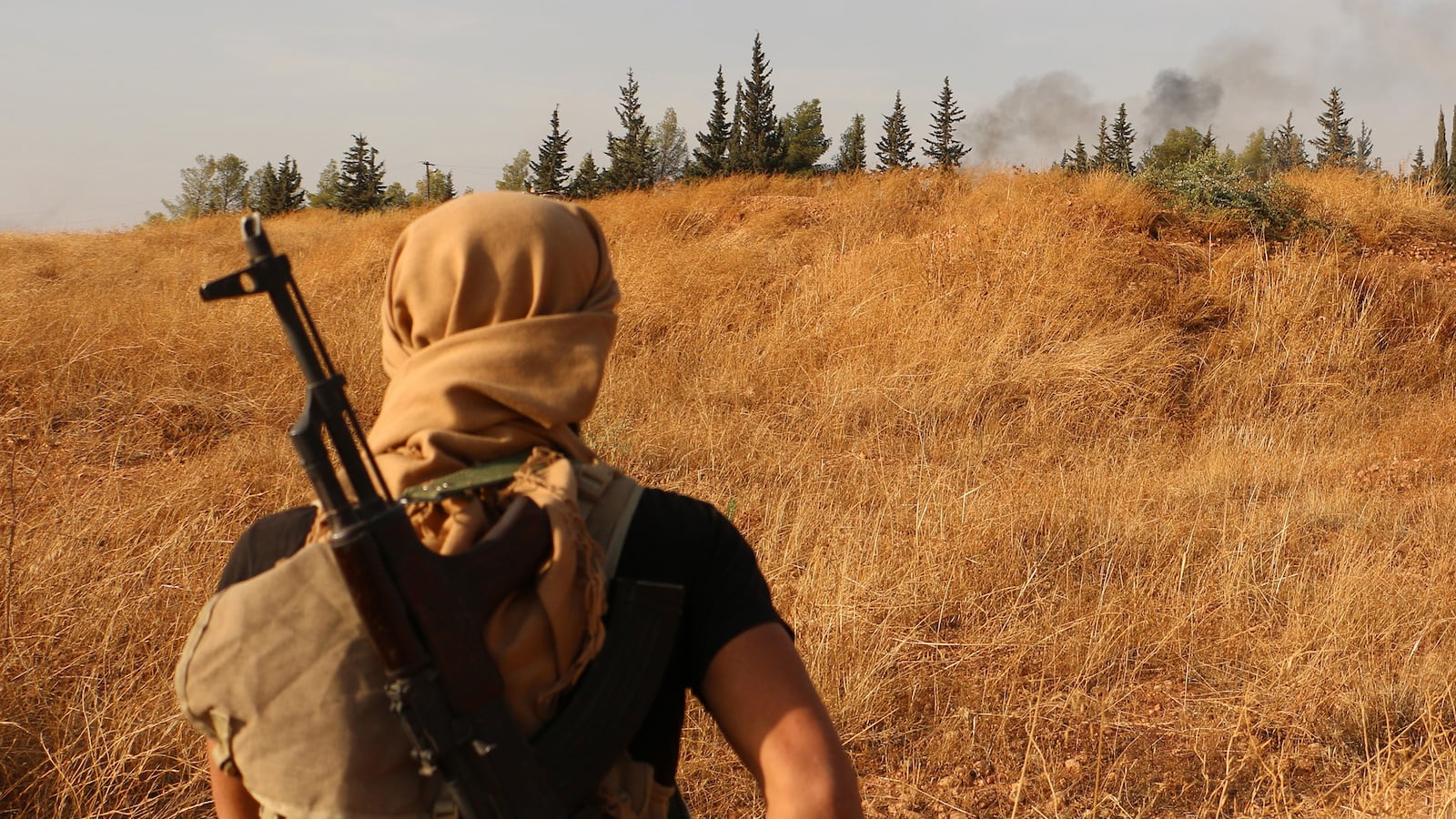Three weeks of Russian aerial bombardment in Syria hasn't exactly helped the Bashar al-Assad regime in its push north of Damascus. Social media has for the last three weeks been awash with images of burning Syrian Arab Army tanks, all wrecked by a tactically powerful anti-tank missile, the BGM-71 TOW, supplied (via Saudi Arabia) by the United States to certain CIA-backed anti-Assad militias.
Yesterday, two large rebel umbrella groups—Jaysh al-Fateh (Army of Conquest), a large consortium of Islamists which includes the official Syrian al-Qaeda franchise, and the Free Syrian Army, an admittedly catchall category but one that includes 39 CIA-vetted TOW recipients—announced a major counteroffensive.
The push is taking place in northern Hama and the eastern hills of Latakia. This coastal province is the Assad family’s homeland—and the area where Russia has constructed a forward operation base and headquarters for its Syrian adventure. Far from being pushed out, the rebels are actually pushing in on Moscow’s military fief in the Levant. ISIS, which Russia disingenuously claims to be focusing its fire and steel on, has also gobbled up geography in Aleppo.
Reports emerged earlier this week that rebel shelling may have even killed three Russian servicemen in Latakia, an allegation denied by the Kremlin, which insists it hasn’t any ground troops in Syria. But given the plausibility of the claim, and its provenance in pro-Assad state media, rumors of “Cargo 200”—the Russian military code for combat fatalities—only underscore the so-far lackluster performance of Vladimir Putin’s coalition.
Pro-Assad forces in the battle for Hama include the Syrian Arab Army, Lebanese Hezbollah, the Iran-built National Defense Force militia, and advisors from both the Russian military and Iran’s Revolutionary Guards Corps.
Yet against that multinational array, the FSA has managed to hold its ground because its campaign is clearly being coordinated and encouraged by Western and regional intelligence services, which have displayed a newfound willingness to allow more defensive weaponry to their proxies.
As Charles Lister, an analyst of Syria’s multifarious insurgency at the Brookings Institution, calculated, the use of the TOW missile has increased a staggering 850% since the Russians started bombing, a metric that bolstered by press accounts featuring rebels attest to sudden bonanza of the tank-killer. Also reappearing on the battlefield is the RBG-6 multiple grenade launcher, a munition purchased by the Saudis from Croatia and imported into southern Syria via Jordan in 2013. (That supply line was abandoned after the launcher was found in the hands of jihadists not long after its import.)
Evidence of rebel victories is everywhere on social media. Here’s a video of Liwa Suquour al-Jabal destroying an artillery gun with a TOW missile in Khirbat al Naqus, near Latakia. Here’s one of a BMP being wiped out with a TOW near al-Qarassi, Aleppo, a town the rebels appear to have sacked, along with Tel Qurha, which lies just hundreds of meters south of a regime army base. According to the opposition-run Local Coordination Committees, Jaysh al-Fateh seized the village of Mansoura in Hama today after intense combat with pro-regime forces. The FSA participated in that operation, too, because the same anti-tank missile system was put to use in Mansoura.
Mohammed Rasheed, a fighter with Suqur al-Ghab, one of the CIA-backed militias fighting in Hama, told The Daily Beast, “We have managed to liberate two towns; Mea’ar Kabi in the northern [suburb] of Hama and Lahaya. We have been planning for this operation since the start of the Russian invasion. We wanted to reverse the situation and attack them instead of just defending ourselves.” Rasheed said that his brigade destroyed 23 regime tanks and killed 15 Syrian soliders— in the last 24 hours. “What helped us in this operation is that we all got united and fought as one army.”
Major Raed al-Saleh, a commander of Tajammu al-Izza, another TOW-toting militia in Hama, added to the rebel haul today two destroyed tanks, a captured one, and a 23-milimeter artillery gun that is no more. Al-Saleh also relayed that his men were able to intercept the enemy’s communications and discovered that Russians aren’t so thrilled with how Assad’s army has comported itself thus far. A dispute was apparently overhead between a Russian general and Syrian Gen. Jamal Younis, who was until recently the head of Assad’s security committee in Hama. “Younis was moved aside because the Russian was angry with the Syrian army’s lack of strength and its inability to capture territory from the rebels,” al-Saleh said.
The FSA’s advances are more remarkable for the beating it has continued to take by Russian airstrikes. Mustafa al-Me’rati, a spokesperson for Tajamu al-Izza, told The Daily Beast late this afternoon: “Half an hour ago, our headquarters and a hospital in Latamna were attacked and destroyed by the Russian airstrikes. All the hospital staff were injured, but one was killed. The attack is the Russian response to our victory in Mea’ar Kabi. The FSA has changed the rules of the game today. We have managed to attack instead of defend, and that is on many fronts.” And it isn’t just the Russians chafing under the ineffectiveness of their client, he said. “We’ve heard that the Iranians are quite upset and screaming in the joint operations room [in Latakia]. It is a big day for us.”
Gains were also registered in Aleppo, where ISIS has lately exploited Russia’s concentration of firepower on a common adversary. Zakaria Malhafji, head of political office of Division 1, another U.S.-backed FSA group, said “the reason for our success today [in Aleppo] is that we opened severals fronts and kept the regime busy in multiple places. They didn’t expect this and it helped weaken them. Despite their Russian and Iranian support, we managed to get back two villages in the southern [suburbs] in Aleppo while our friends did the same in Hama.”
Malhafji, however, denied that for greater resupplies have been forthcoming from Western and regional allies. “Everyone was talking about the difference in the support we get from the Friends of Syria, but in fact we haven’t received anything different than before the Russian attacks. Yet we managed to achieve victory.”
Ironically, one man aware of the role the West is playing in keeping the FSA in rockets and bullets is Putin. In a confrontational speech Friday, the Russian president dismissed the existence of moderate anti-regime fighters in Syria, while also acknowledging the limits of his own adventurism. “In actual fact,” he said, “we now see a real mix of terrorist groups. True, at times militants from the Islamic State, Jabhat al-Nusra and other Al-Qaeda heirs and splinters fight each other, but they fight for money, for feeding grounds, this is what they are fighting for.”
In other words, there is no Free Syrian Army; if the West is backing anyone, it’s backing terrorists. Putin more or less carried the thought to conclusion, remarking on what his air force has lately been blowing up—apart from hospitals and ambulances, that is. (A recent analysis conducted by the London-based Syrian Observatory for Human Rights found that Russian airstrikes have so far killed 151 civilians, 189 FSA and Islamist rebels, and just 31 Nusra and 75 ISIS jihadists.)
“I watch the video reports after the strike and they make an impression,” Putin said. “Such a quantity of ammunition goes off there that it flies practically all the way up to the planes. You get the impression that they have collected arms and ammunition from throughout the entire Middle East. They have put together a colossal amount of arms. You can’t help but wonder where they get the money from. It’s really a tremendous amount of firepower they’ve accumulated. Now, of course, it is less than it was. The Syrian army really is making gains with our support. The results are modest for now, but they are there, and I am sure that there will be more.”
—with additional reporting by Mais al-Bayaa and James Miller






